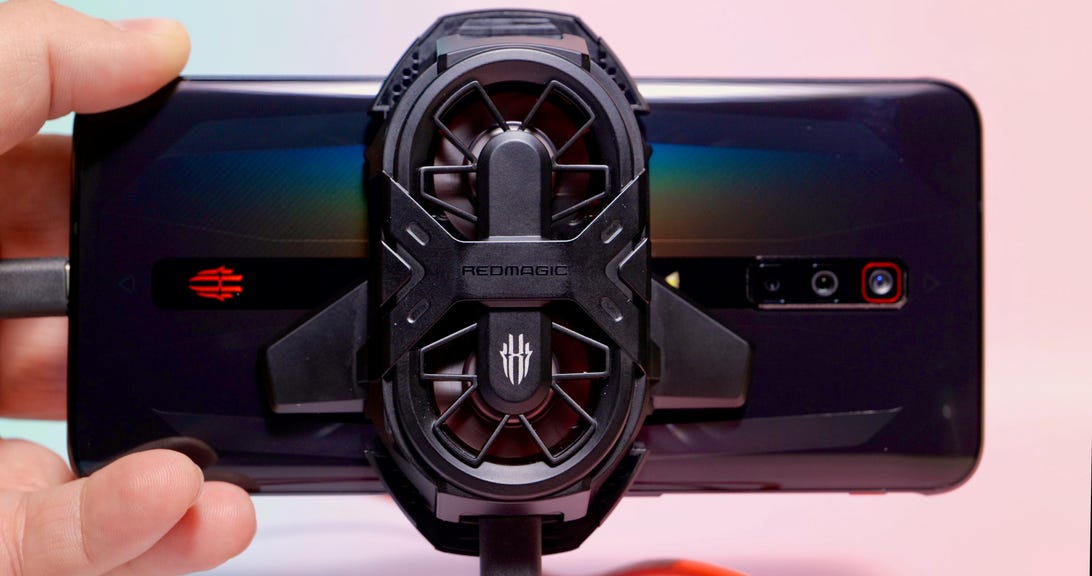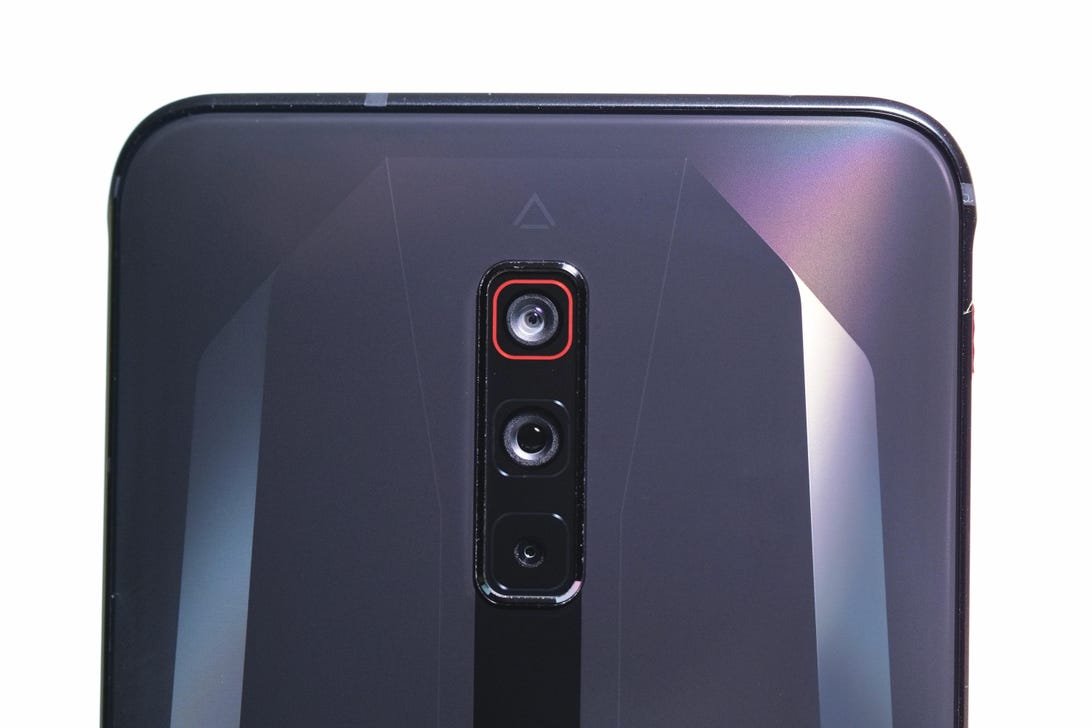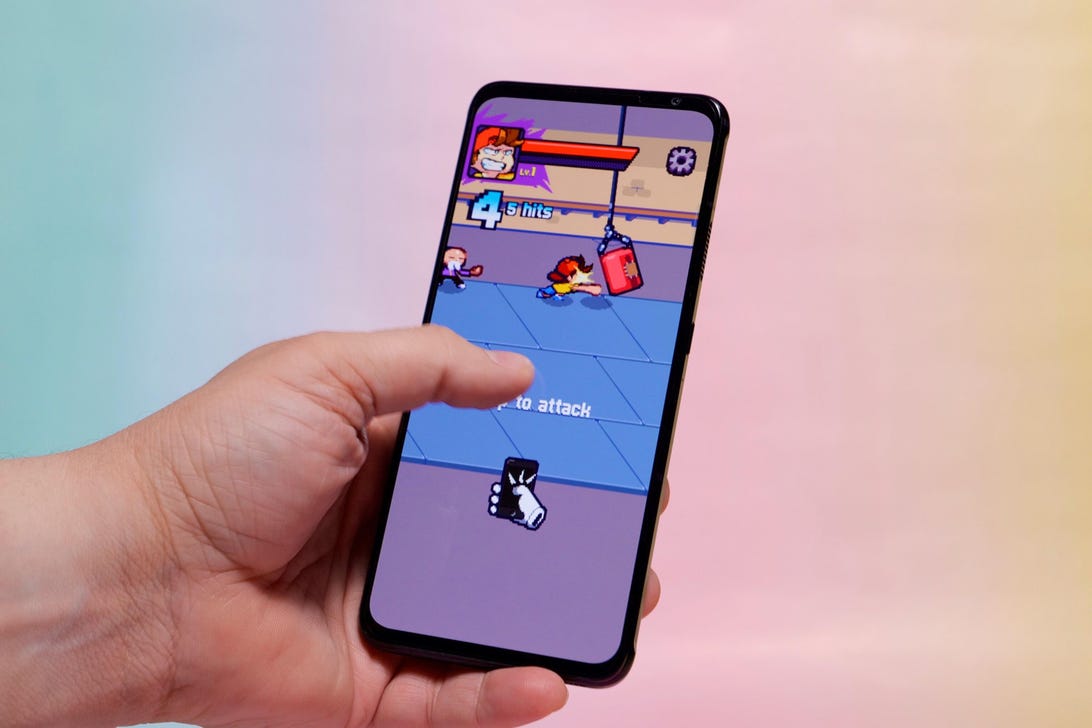The RedMagic 6 has an internal fan. But if that’s not enough, you clip onto the back the Dual-core Ice Dock, a fan that lights up.
Patrick Holland/CNET
If you’re into mobile gaming, 2021 is an excellent year because in the past couple weeks alone three gaming phones have been released. The Asus ROG Phone 5 made a splash with its everything-and-a-kitchen-sink approach to features and specs. On Thursday, Lenovo released the Legion Phone Duel 2, which has an unusual design even for a gaming phone. And now there’s the Nubia RedMagic 6 and its first-of-a-kind 165Hz refresh-rate screen. With so many options, what sets the RedMagic apart is its incredible value: a $599 price tag (or £509, which converts roughly to AU$915), a large battery, top-of-the-line Android performance and a heaping amount of customizable game settings only add to its appeal. But beyond gamers, the RedMagic 6’s appeal is limited.
Like
- 165Hz high-refresh-rate screen
- Amazing performance
- Good value for the price
Don’t Like
- Missing ultrawide camera button in Photo mode
- Lack of IP-rated water resistance
- Screen hard to see in sunlight
Most phones, including the iPhone 12, have a 60Hz display. The RedMagic’s 165Hz screen looks incredibly smooth. There are actually a lot of games that support 165 frames per second, though many mainstream titles don’t. It’s hard to describe the difference between a 120Hz screen like on the Galaxy S21 Ultra, a 144Hz display like on the ROG Phone 5 and the RedMagic’s 165Hz panel. But compared to a 60Hz display, the RedMagic 6 is like a first-class seat for your eyes.
The screen supports 10-bit colors and has a 500Hz single-touch rate and 360Hz multitouch rate, which makes gameplay feel responsive. When I played games like PUBG or Beat Street, on-screen presses and taps felt more accurate.
On the left side of the phone is a red button that looks like a silent mode switch, but it’s not. When you slide it over, the RedMagic 6 comes alive. The switch puts you into the Game Space: Think of it like a library, control room and arena for playing games. You can choose titles, control the lighting and internal fan — all while muting notifications and other nongaming distractions.
During gameplay, Game Space controls can be accessed with just a simple finger slide. For example, if a game wasn’t actually hitting 165fps, I could lower the frame rate without exiting the game. The Game Space control panel also has shortcuts for screen brightness, mapping game controls, creating macros for repetitive input, recording gameplay and more. There is even a 4D vibration mode that works kind of like a PlayStation or Xbox controller, albeit not as nuanced.
On the side of the phone are two touch-sensitive areas that can be used as shoulder buttons for games. The shape of the phone’s corners make them easy to find. Button taps felt reassuring, and I rarely made mistakes. Part of that might also be that the side inputs have a 400Hz refresh rate.
The RedMagic 6 has a built-in fan. It took a while to get used to a phone sounding like my laptop with multiple tabs open in Chrome. Luckily, fan speed can be adjusted. And if one fan isn’t enough, you can buy the Dual-core Ice Dock accessory which adds two more. The exterior dual-fan unit clips onto the back of the phone, adding more airflow and even more noise.

The RedMagic 6 with the Dual-core Ice Dock attached.
Patrick Holland/CNET
During long bouts of gaming, the RedMagic 6 never got too hot to hold. The internal fan, along with the phone’s liquid and graphite cooling systems, made it one of the most comfortable phones to play games on in terms of temperature.
Powering the phone is a 5,050-mAh battery that made it through a day with no problem. Though it comes with a 30-watt charger, the RedMagic 6 supports 66-watt fast charging. I am in the process of running more in-depth battery tests and will update this review with the results.
The RedMagic 6 has a Snapdragon 888 processor, and my review unit had 12GB of RAM. (There is a RedMagic 6 Pro model that comes with 16GB of RAM.) In performance tests, the RedMagic 6 scored at the top of the 2021 class of Android phones along with the Asus ROG Phone 5. That said, the iPhone 12 Pro still scored higher than both.
3DMark Slingshot Unlimited
Asus ROG Phone 5 Ultimate
Note:
Longer bars indicate better performance
Geekbench v.5.0 single-core
Asus ROG Phone 5 Ultimate
Note:
Longer bars indicate better performance
Geekbench v.5.0 multicore
Asus ROG Phone 5 Ultimate
Note:
Longer bars indicate better performance
The RedMagic 6 has a headphone jack, support for 5G, Wi-Fi 6E and NFC, and it runs on Android 11. My review unit has “Tencent Games” written on the back, but the actual US model won’t. And if all you did was game, then this $599 phone is worth every penny. But outside of gaming, there are some downsides.

The RedMagic 6 has a triple-rear camera.
Patrick Holland/CNET
The RedMagic 6 has a main 64-megapixel camera, an 8-megapixel ultrawide camera and a 2-megapixel bokeh camera for depth. The main camera takes decent photos and can even record HDR10 videos. But accessing the ultrawide camera is tricky. In Photo mode, there isn’t a button to switch to the ultrawide camera: You have to go into Pro mode in order to use it. It’s weird and hopefully can be fixed with a software update.

In good lighting, the wide 64-megapixel camera captures great photos.
Patrick Holland/CNET

The detail in the tree roots is good, and the phone was able to capture the blue sky without blowing it out to white.
Patrick Holland/CNET

I like how the phone captured the colors of this presunset moment.
Patrick Holland/CNET

The RedMagic 6 doesn’t have a dedicated telephoto camera. This was taken at a 3x digital zoom. The photo looks decent, but things start to fall apart past 3x zoom.
Patrick Holland/CNET
As impressive as the screen is, it’s also pretty dim. In a bright room or outdoors, it can be hard to see it clearly. The RedMagic 6 is also heavy, making one-handed game play nearly impossible. It doesn’t have an IP rating for dust or water resistance, and it lacks wireless charging. And I’m not the biggest fan of the RedMagic OS.
The Dual-core Ice Dock is tricky to set up. A USB-C cable connects it to the phone. The instructions say to pair it to the phone via Bluetooth. I tried many times to do this, but could only get the Ice Dock to work using the cable. And who wants to game with a cable attached to the bottom of the phone and to an external clip-on fan?

The RedMagic 6 is heavy and wide which makes one-handed game play a challenge.
Patrick Holland/CNET
I am not the target audience for the RedMagic 6. Mobile gamers are. And until Asus and Lenovo announce an official US price for their gaming phones, the RedMagic 6 represents a good value for the price.
Nubia RedMagic 6 specs vs. Asus ROG Phone 5, ROG Phone 5 Pro, ROG Phone 5 Ultimate
| Nubia RedMagic 6 | Asus ROG Phone 5 | Asus ROG Phone 5 Pro | Asus ROG Phone 5 Ultimate | |
|---|---|---|---|---|
| Display size, resolution | 6.8-inches OLED, 2,400×1,080 pixels, 165Hz refresh rate, HDR10, 500Hz single touch rate | 6.78-inch AMOLED, 2,448×1,080 pixels, 144Hz refresh rate, HDR10+, 300Hz touch rate | 6.78-inch AMOLED, 2,448×1,080 pixels, 144Hz refresh rate, HDR10+, 300Hz touch rate | 6.78-inch AMOLED, 2,448×1,080 pixels, 144Hz refresh rate, HDR10+, 300Hz touch rate |
| Pixel density | 387ppi | 395ppi | 395ppi | 395ppi |
| Dimensions (Inches) | 6.69 x 3.04 x 0.38 in | 6.09 x 2.72 x 0.36 in | 6.09 x 2.72 x 0.36 in | 6.09 x 2.72 x 0.36 in |
| Dimensions (Millimeters) | 170 x 77 x 9.7mm | 173 x 77 x 10.3 mm | 173 x 77 x 10.3 mm | 173 x 77 x 10.3 mm |
| Weight (Ounces, Grams) | 7.76 oz; 220g | 8.57 oz; 243g | 8.57 oz; 243g | 8.57 oz; 243g |
| Mobile software | Android 11 | Android 11 | Android 11 | Android 11 |
| Camera | 64-megapixel (wide), 8-megapixel (ultrawide), 2-megapixel (depth) | 64-megapixel (wide), 13-megapixel (ultrawide), 5-megapixel (macro) | 64-megapixel (wide), 13-megapixel (ultrawide), 5-megapixel (macro) | 64-megapixel (wide), 13-megapixel (ultrawide), 5-megapixel (macro) |
| Front-facing camera | 8-megapixel | 24-megapixel | 24-megapixel | 24-megapixel |
| Video capture | 8K | 8K | 8K | 8K |
| Processor | 2.84GHz Snapdragon 888 5G | 2.84GHz Snapdragon 888 5G | 2.84GHz Snapdragon 888 5G | 2.84GHz Snapdragon 888 5G |
| Storage | 128GB UFS3.1 | 128GB, 256GB UFS3.1 | 512GB UFS3.1 | 512GB UFS3.1 |
| RAM | 12GB | 8GB, 12GB, 16GB | 16GB | 18GB |
| Expandable storage | None | None | None | None |
| Battery | 5,050 mAh | 6,000 mAh (2x 3,000 mAH) | 6,000 mAh (2x 3,000 mAH) | 6,000 mAh (2x 3,000 mAh) |
| Fingerprint sensor | In-screen | In-screen | In-screen | In-screen |
| Connector | USB-C | USB-C | USB-C | USB-C |
| Headphone jack | Yes | Yes | Yes | Yes |
| Special features | 5G-enables, 66W fast charging, 400Hz touch sensitive side buttons, RGB lighting and logo, Game Space hardware switch, Wi-Fi 6E, NFC, dual-SIM | 5G-enabled, 65W quick charging, ROG logo, Wi-Fi 6E, Dual-SIM, Comes with case | 5G-enabled, 65W quick charging, ROG Color Vision display, Wi-Fi 6E, Dual-SIM, Comes with case and AeroActive Cooler 5 | 5G-enabled, 65W quick charging, ROG Black and White Vision display, Wi-Fi 6E, Dual-SIM, Comes with case and AeroActive Cooler 5 |
| Price off-contract (USD) | $599 | TBA, but European prices convert to $950 (8GB RAM, 128GB storage), $1,065 (12GB RAM, 256GB storage), $1,185 (16GB RAM, 256GB storage) | TBA, but European price converts to $1,420 (16GB RAM, 512GB storage) | TBA, but European price converts to $1,540 (18GB RAM, 512GB storage) |
| Price (GBP) | £509 | TBA, but European prices convert to £685 (8GB RAM, 128GB storage), £770 (12GB RAM, 256GB storage), £855 (16GB RAM, 256GB storage) | TBA, but European price converts to £1,025 (16GB RAM, 512GB storage) | TBA, but European price converts to £1,110 (18GB RAM, 512GB storage) |
| Price (AUD) | UK price converts to AU$915 | TBA, but European prices convert to AU$1,235 (8GB RAM, 128GB storage), AU$1,390 (12GB RAM, 256GB storage), AU$1,540 (16GB RAM, 256GB storage) | TBA, but European price converts to AU$1,850 (16GB RAM, 512GB storage) | TBA, but European price converts to AU$2,000 (18GB RAM, 512GB storage) |


Be the first to comment